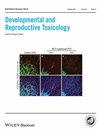父亲高龄与后代肌肉骨骼先天性异常的风险。
Q Environmental Science
Birth defects research. Part B, Developmental and reproductive toxicology
Pub Date : 2015-12-01
DOI:10.1002/bdrb.21167
引用次数: 14
摘要
目的以往的研究表明,父亲年龄的增加会增加后代发生肌肉骨骼先天性异常(CAs)的风险,但研究结果并不一致。本研究的目的是调查肌肉骨骼癌的风险根据父亲的出生年龄在一个未选择的人口覆盖队列的儿童。研究设计一项基于登记的前瞻性研究,研究对象为1978-2004年在丹麦出生的1,605,885名儿童,使用与记录相关的健康和行政登记信息。通过多元logistic回归分析,研究了父亲年龄与整体肌肉骨骼ca、肢体异常、颅缝闭锁、骨骼发育不良、综合征性肌肉骨骼ca和其他肌肉骨骼ca之间的关系。结果对于整体肌肉骨骼类癌,父亲年龄每增加10年,风险略高(优势比[OR] = 1.06 [95% CI: 1.01-1.11;其中CI为置信区间])。与30-34岁的父亲相比,50岁以上的父亲的风险高出26% (95% CI: 2-56%)。对于综合征型肌肉骨骼ca,与30-34岁的父亲相比,40岁以上的父亲风险更高(40-44岁:OR = 1.38 [95% CI: 1.01-1.88], 45-49岁:OR = 1.45 [95% CI: 0.89-2.34], 50岁以上:OR = 1.42 [95% CI: 0.73-2.79])。在50岁以上的父亲中,所有其他肌肉骨骼ca亚组的风险都增加了。结论随着父亲年龄的增加,后代整体肌肉骨骼癌的风险略高,这主要是由于40岁以上父亲患综合征性肌肉骨骼癌的风险过高。虽然表明父亲年龄50岁以上与所有肌肉骨骼ca亚型风险增加之间存在关联,但父亲年龄较大可能在这些异常的病因学中起次要作用。本文章由计算机程序翻译,如有差异,请以英文原文为准。
Advanced Paternal Age and Risk of Musculoskeletal Congenital Anomalies in Offspring.
OBJECTIVE
Previous research suggests that advanced paternal age increases the risk of musculoskeletal congenital anomalies (CAs) in offspring, but findings are inconsistent. This study aims to investigate the risk of musculoskeletal CAs according to paternal age at birth in an unselected population covering cohort of children.
STUDY DESIGN
A register-based prospective study of 1,605,885 children born in Denmark, 1978-2004, using information from record-linked health and administrative registers. The association between paternal age and overall musculoskeletal CAs, limb anomalies, craniosynostosis, skeletal dysplasias, syndromic musculoskeletal CAs, and other musculoskeletal CAs were investigated by multiple logistic regression analysis.
RESULTS
For overall musculoskeletal CAs, a slightly higher risk per 10-year increase in paternal age was found (odds ratio [OR] = 1.06 [95% CI: 1.01-1.11; where CI is confidence interval]). A 26% (95% CI: 2-56%) excess risk was found for fathers aged 50+ years compared to fathers aged 30-34 years. For syndromic musculoskeletal CAs, excess risks were found for fathers aged 40+ years, compared to fathers aged 30-34 years (40-44: OR = 1.38 [95% CI: 1.01-1.88], 45-49: OR = 1.45 [95% CI: 0.89-2.34], 50+: OR = 1.42 [95% CI: 0.73-2.79]). The risks in all other subgroups of musculoskeletal CAs were increased for fathers aged 50+ years.
CONCLUSIONS
A slightly higher risk for overall musculoskeletal CAs in offspring was found with increasing paternal age, mainly due to an excess risk of syndromic musculoskeletal CAs for fathers aged 40+ years. While associations between paternal age 50+ years and increased risk of all subtypes of musculoskeletal CAs were indicated, advanced paternal age likely plays a minor role in the etiology of these anomalies.
求助全文
通过发布文献求助,成功后即可免费获取论文全文。
去求助
来源期刊
CiteScore
1.65
自引率
0.00%
发文量
0
审稿时长
>12 weeks
期刊介绍:
The purpose of this journal is to publish original contributions describing the toxicity of chemicals to developing organisms and the process of reproduction. The scope of the journal will inlcude: • toxicity of new chemical entities and biotechnology derived products to developing organismal systems; • toxicity of these and other xenobiotic agents to reproductive function; • multi-generation studies; • endocrine-mediated toxicity, particularly for endpoints that are relevant to development and reproduction; • novel protocols for evaluating developmental and reproductive toxicity; Part B: Developmental and Reproductive Toxicology , formerly published as Teratogenesis, Carcinogenesis and Mutagenesis

 求助内容:
求助内容: 应助结果提醒方式:
应助结果提醒方式:


